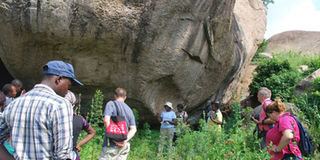Nyero rock paintings, the untold view of the gods

A team of archaelogists and historians tour the Nyero rock with inscriptions as old as 4,000 years. PHOTOs. by Willis Omith
What you need to know:
In a world so affluent, high paced and sophisticated with 3-D technology and communications norm, an opportunity to experience pre-history is invaluable. the art pieces engraved on these rocks show that our ancestors knew how to communicate and were not as primitive as we thought.
When we set off with a group of archaeologists who were meeting in Jinja courtesy of the British Academy UK-Africa partnership programme, I never thought Nyero rock paintings, in the south eastern district of Kumi, would provide a perfect reflection on nature and our ancestry.
Nyero is like any other village in rural Uganda, with its people growing cassava, millet and sorghum to earn a livelihood until you notice magnificent stones, standing tall in the air, one hanging on the other.
Ms Rose Mwanja Nkaale, the commissioner of museums and monuments, says,Nyero art proves an early civilisation, a fact that Uganda has a place in the history of civilisation, just like Egyptians are remembered for their Hieroglyphics.
The inscriptions according to the experts date back to about 4,000 years. This is a phenomenon that helps us retrace our heritage, or at least, the roots of the Iteso people who have inhabited the area for over four centuries.
No one puts a spin better than Stanley Odemu, a local guide, who has mastered the art of telling stories about the rocks, and how they became the cradle of Iteso.
History behind it
“We came from Abyssinia, the present day Ethiopia,” he starts. “We came following the Nile River downstream in search of pasture because we are traditionally herdsmen.
“When we reached the plains of north eastern Uganda, part of the group got tired and decided to stay. For us we continued, naming the group behind Akarimajong, because they were an old and lazy bunch,” he says.
When the Iteso came down south, they found rocks that would shield them from external threats. Odemu talks about threats like a monster they found in the river, as they tempted to fish during their migration. He says the monster ate them one by one, forcing them to flee down south. At Nyero rocks, they found a perfect place to guard them from harm. Here, they put up a settlement and civilisation from where he traces the rock art paintings. He refers to the boat and crocodile kind of images, to emphasise a point.
But Dr Catherine Namono, a Ugandan rock art expert based at Wits University in South Africa, disagrees with him given the extensive studies she has done on the shapes of art on the rocks. She says this particular art is similar to the one she has seen among Ntwa people, the pygmies who live in the equatorial forests.
She says she has seen similar art among Mbuti people in Ituri forest in DR Congo, and goes ahead to link it with the forms of art in the greater Lake Victoria basin given their encyclical nature, dominated by red and white colours. That does not mean Odemu’s narrative is useless.
The rock art
The art inscribed on the rocks are mainly in geometrical forms –some cannot be understood, but one can tell forms like boats, human faces, the sun, and the cross. One would think the cross was a Christian symbol. There are no conclusive studies that have so far been made on the rock paintings at Nyero since Uganda has been short of archaeologists to study them.
The rock art painted using mainly white and red colours are invaluable to archaeologists and historians in the country whose fields of study have been shallow in the absence of records of how life was like before Africans came into contact with Arabs and Europeans.
African history has since been written by non-Africans and studies thereafter have been from that point of view. What has been excavated at Nyero so far, overrides the story of Iteso told by Mzee Odemu.
Is it possible pygmy-like people inhabited this area before the coming of Iteso, given the resemblance with the kinds of art found in other parts of the continent like Dr Namono says – and how did the pygmies leave the plains for the equatorial rainforest region?
Odemu says, it is at the Nyero rock that the sun god was found. He says that explains the circular drawings on the rock in the imposing red colour.
There was also a god responsible for rain- making. Untill today, people make sacrifices to the god during drought.
the fertility god
But that is not enough– Nyero is where the fertility god was also found. Dr Namono showed us the rock with space under which one could lay down. Those barren women used to go and lie while facing the rock as they asked the god to give them children. Upon getting a child, a couple would return and prepare a meal in thanksgiving to the gods. Mr Odemu quips in – “For me I asked for nine, but the gods were very generous and they gave me 10 children.”
Though the law protects such cultural sites, the government is yet to implement it to protect it from vandalism.
Like the story Odemu tells of witchdoctors, who he accuses of introducing new beliefs and pouring oil on the rocks washing out some of the painting. The rocks are not protected physically from encroachers.
Though the community has no mandate to collect anything from anyone, when they take tourists around, they are tipped with some money which has significantly changed their lives.
Nyero stones not only remind the residents of their heritage, but have also become a source of their survival.
[email protected]




